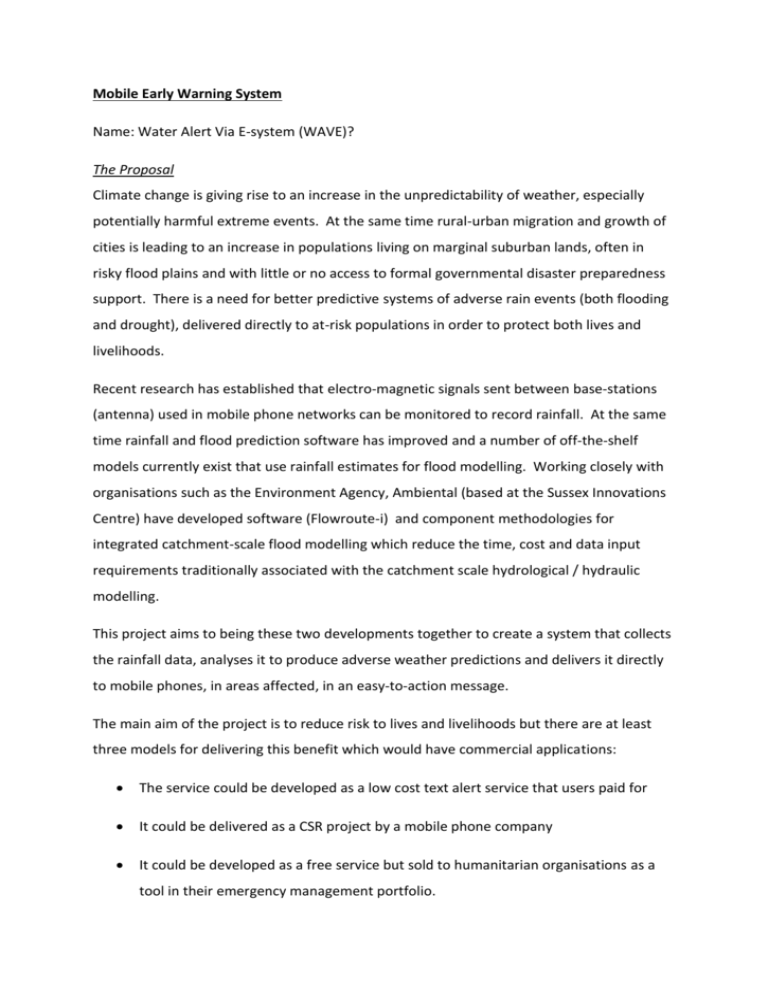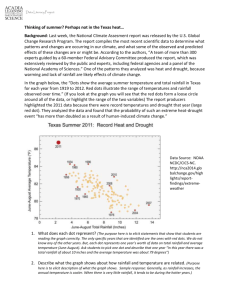wave - OpenIDEO
advertisement

Mobile Early Warning System Name: Water Alert Via E-system (WAVE)? The Proposal Climate change is giving rise to an increase in the unpredictability of weather, especially potentially harmful extreme events. At the same time rural-urban migration and growth of cities is leading to an increase in populations living on marginal suburban lands, often in risky flood plains and with little or no access to formal governmental disaster preparedness support. There is a need for better predictive systems of adverse rain events (both flooding and drought), delivered directly to at-risk populations in order to protect both lives and livelihoods. Recent research has established that electro-magnetic signals sent between base-stations (antenna) used in mobile phone networks can be monitored to record rainfall. At the same time rainfall and flood prediction software has improved and a number of off-the-shelf models currently exist that use rainfall estimates for flood modelling. Working closely with organisations such as the Environment Agency, Ambiental (based at the Sussex Innovations Centre) have developed software (Flowroute-i) and component methodologies for integrated catchment-scale flood modelling which reduce the time, cost and data input requirements traditionally associated with the catchment scale hydrological / hydraulic modelling. This project aims to being these two developments together to create a system that collects the rainfall data, analyses it to produce adverse weather predictions and delivers it directly to mobile phones, in areas affected, in an easy-to-action message. The main aim of the project is to reduce risk to lives and livelihoods but there are at least three models for delivering this benefit which would have commercial applications: The service could be developed as a low cost text alert service that users paid for It could be delivered as a CSR project by a mobile phone company It could be developed as a free service but sold to humanitarian organisations as a tool in their emergency management portfolio. Initially the project was conceived as applicable in regions where surface based rain radar does not exist such as Africa and a number of relationships exist with organisations specifically in in Senegal (Senegalese Red Cross, Agence Nationale de l'Aviation Civile et de la Météorologie du Sénégal, Sonatel) which means it might be quick to develop a trial there. The system would also be applicable in many other regions. South and South-East Asia would also be possible areas where a system such as the one proposed here would have beneficial applications. Annual flood events in Asia have tripled with economic losses and human casualties increased more than five-fold in the last 30 years, and the high rate of urbanization and population growth in these regions are likely to aggravate the situation, especially in low-lying large coastal cities. (An Assessment of the Socio-Economic Impacts of floods in Large Coastal Areas, Final Report for APN CAPaBLE Project: 2004-CB01NSY-Dutta, Asian Institute of Technology). Failings of existing provision Rainfall observations are notoriously sparse for many parts of the world with a poor distribution of raingauges, a lack of operational surface based rain radars and delays in transferring and processing satellite based rainfall estimation data (Hellmuth et al. 2007). In the tropics, in particular, rainfall is highly variable in space and time, changing over tens of metres and minutes. By comparison raingauge data are point measurements that rely on the autocorrelation of rainfall over space to estimate rainfall in locations not immediately covered by the gauge. Satellite data on the other hand, is infrequent in terms of how often they cover a particular area, relying on temporal autocorrelation to estimate rainfall for periods when there is no satellite coverage and of comparatively poor resolution in space. The resulting impact of these measurement shortcomings are a lack of timely and accurate early warnings of floods and droughts at small spatial and temporal scales Other applications There is a wide variety of applications for rainfall predictions such as flood and drought monitoring by (re-)insurers, risk managers, utilities, governments, and land / property professional, for urban locations where spatial and temporal scales are small. The measurement and provision of rainfall data at scales consummate with user demand is often limited by existing observation networks. How it works Commercial cellular communication networks cover large parts of the land surface of the earth and have a high density, particularly in urban and peri-urban areas. The electromagnetic signals transmitted between antennas (base stations) within this network are attenuated by rainfall. By measuring the received power at one end of a microwave link as a function of time, the attenuation due to rainfall can be calculated. These received powers are a by-product of the communication between mobile telephones and are, in general, only used to monitor the stability of the link connection. However a number of studies (Messer et al. 2006; Leijnse et al. 2007; Zinevich et al. 2009) have shown that average rainfall intensities over the length of a commercial single-frequency microwave link can be derived from the attenuation. Antennas within the cellular network are located in varying patterns with each base station having a range from less than 1km in cities to 8km in rural areas. Therefore using the measured strength of signal at base stations allows an estimate of rainfall intensity for a network of surface vectors at high spatial resolution, continuously over time. Using a variety of geospatial techniques these integrated rainfall measurements can then be mapped to produce rainfall fields in virtually real time (Zinevich et al 2008). These fields can then be used to monitor the advection of the convective weather systems and input into a flood modelling scheme to forecast flooding and this information disseminated directly via mobile phones. Development of the technical component of the early warning system will comprise the retrieval of Received Signal Level (RSL) measurements; the conversion of these data into rainfall measurements; identification of convective rain cells; advection of cells; the input of these data into the flood model and overlay of model outputs on population information. A stand alone software system will be developed to process the data and derive alerts. The methodology used to convert the RSL data to gridded rainfall data follows the work of Goldshtein et al (2009) with a four stage approach of preprocessing; point rain rate estimation; line to points data conversion and generation of rain maps. Gridded rainfall data can then be input into the hydrological model to determine the ongoing flood response. The derivation of alerts from the model runs would be developed with input from stakeholders including the community, and those responsible for the humanitarian response.







